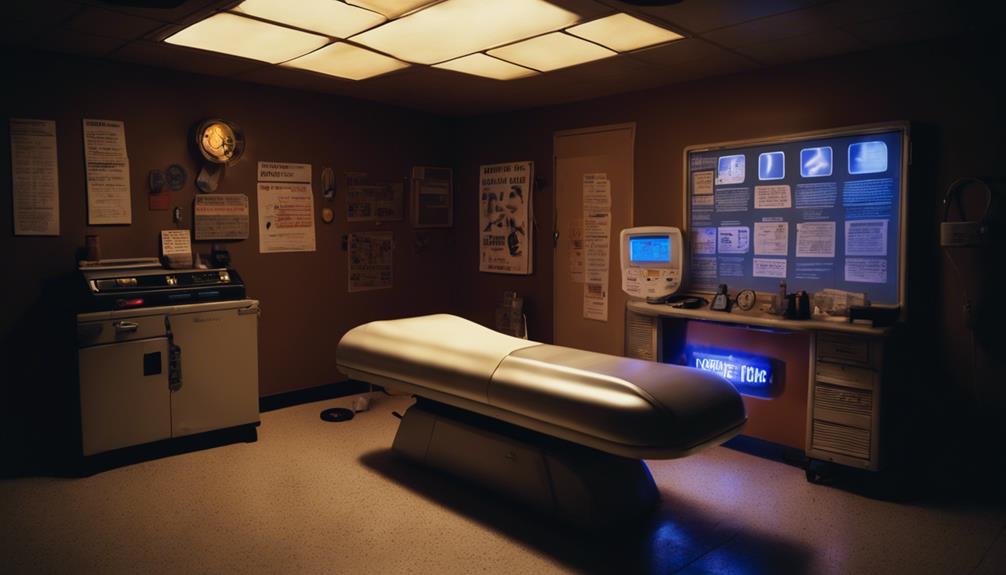Using tanning beds exposes you to harmful UV rays, increasing the risk of skin cancer, particularly melanoma. These intense rays can result in premature aging, wrinkles, and severe eye damage if you do not wear protective goggles. To protect yourself, limit your tanning sessions, always wear UV-blocking goggles, and apply broad-spectrum sunscreen with a high SPF beforehand. It is crucial to regularly check your skin for any unusual changes and consult a doctor if needed. If you are seeking safer alternatives to achieve a tan without the dangers, there are plenty of options available to help you maintain your skin’s health while still looking fabulous.
Key Takeaways
- Tanning beds significantly increase the risk of skin cancer, including melanoma, due to intense UV exposure.
- UVA and UVB rays from tanning beds cause premature aging, leading to wrinkles and sagging skin.
- Always wear UV-blocking goggles to prevent severe eye damage when using tanning beds.
- Explore safer alternatives like self-tanning lotions and professional spray tans to achieve a tan without harmful UV exposure.
The Science of UV Rays
UV rays, which come in three types—UVA, UVB, and UVC—are the primary culprits behind the skin damage and health risks associated with tanning beds.
UVA rays make up about 94% of the UV radiation you encounter, penetrating deep into your skin and contributing to premature aging and an increased risk of melanoma.
On the other hand, UVB rays, though less prevalent, are much stronger and can cause painful sunburns while greatly raising your skin cancer risk.
Tanning beds amplify this exposure, delivering concentrated doses of UVA and UVB that can exceed natural sunlight.
Understanding these rays helps you make informed choices about your tanning habits and the potential consequences for your skin and overall health.
Health Risks of Tanning Beds

Using tanning beds greatly heightens your risk of developing skin cancer and experiencing premature aging, making it essential to understand these health threats. The harmful effects of UV radiation in tanning beds can lead to serious long-term consequences for your skin and overall health.
Consider these risks:
- Increased risk of skin cancer, especially melanoma, due to intense UV exposure.
- Premature aging, resulting in wrinkles, sagging skin, and loss of elasticity.
Being aware of these dangers can help you make informed choices about your tanning habits.
Prioritize your health and seek safer alternatives to achieve that desired glow without the added risks.
Essential Safety Precautions

Always prioritize safety by wearing UV-blocking goggles to protect your eyes during tanning bed sessions. These goggles guarantee your eyes are shielded from harmful UVA and UVB rays, reducing the risk of cataracts and other eye damage.
Limit your tanning bed sessions to avoid excessive UV exposure, especially if you're under 18 or have sensitive skin. Before entering the tanning bed, apply a broad-spectrum sunscreen with a high SPF to safeguard your skin.
Regularly check your skin for any unusual changes after tanning, and consult a doctor if you notice anything concerning. By taking these essential safety precautions, you can enjoy your tanning experience while minimizing the associated risks.
Stay informed and protect your skin and health!
Guidelines for Responsible Use

Before stepping into a tanning bed, make sure to establish a clear plan that prioritizes your skin's health and safety.
Here are some guidelines to follow:
- Limit your sessions to reduce cumulative UV exposure.
- Always wear UV-blocking goggles to protect your eyes.
Effective Protective Measures

Protecting your skin while using tanning beds requires a combination of proper gear and proactive measures.
First, always wear UV-blocking goggles to shield your eyes from harmful radiation; they're essential for preventing eye damage.
Limit your tanning sessions to reduce cumulative UV exposure and avoid tanning beds if you're under 18 or have sensitive skin.
Before you tan, apply a broad-spectrum sunscreen with a high SPF to protect your skin.
Additionally, choose bronzer lotions that suit your skin type and contain hydrating ingredients.
Don't forget to monitor your skin for any unusual changes after tanning, and schedule regular check-ups with a dermatologist to keep track of your skin health.
Taking these precautions can greatly reduce your risks.
Common Misconceptions About Tanning

Many people mistakenly believe that tanning beds are a safe way to achieve a bronzed glow without the risks associated with natural sunlight. However, this is far from the truth. In reality, tanning beds are not any safer than natural sunlight and can actually pose even greater risks due to the concentrated exposure to artificial UV rays. Additionally, tanning beds can also be a breeding ground for bacteria and fungi if not properly cleaned and maintained. To minimize the risk of infections and skin irritations, it’s important to follow safety tips for tanning bed cleanliness, such as wiping down surfaces with disinfectant, using protective eyewear, and always showering before and after tanning sessions.
Here are some misconceptions you might encounter:
- Tanning beds don't cause skin damage: Just like the sun, they emit harmful UV rays that can accelerate skin aging and increase cancer risk.
- A base tan protects against sunburn: No tan can provide adequate protection; it only offers a minimal SPF equivalent.
It's essential to recognize these myths to make informed decisions about tanning. Your skin health should always come first.
Alternatives to Tanning Beds

Understanding the risks of tanning beds makes exploring safer alternatives for achieving a sun-kissed glow all the more important.
Instead of harmful UV exposure, consider using self-tanning lotions or sprays, which provide a natural-looking tan without the skin damage. These products come in various formulations, so choose one that suits your skin type.
For a more immediate effect, you can opt for a professional spray tan at a salon. Additionally, bronzers and tinted moisturizers can enhance your skin's appearance without long-term consequences.
Don't forget about sunless tanning wipes for easy application on the go.
With these alternatives, you can enjoy a beautiful tan while protecting your skin from the dangers associated with tanning beds.
Frequently Asked Questions
Can Frequent Tanning Bed Use Lead to Skin Discoloration?
Yes, frequent tanning bed use can lead to skin discoloration. Overexposure to UV rays causes uneven pigmentation and dark spots, affecting your skin's overall appearance. It's important to monitor your skin and limit tanning sessions.
How Long Does a Typical Tanning Bed Session Last?
When it comes to tanning beds, sessions typically last between 10 to 20 minutes. You should always monitor your skin's response, adjusting the time accordingly to avoid overexposure and keep your glow looking fresh.
Are There Specific Skin Types More Affected by Tanning Beds?
Yes, fair-skinned individuals and those with a history of sunburn are more affected by tanning beds. Your skin type can greatly influence the risks associated with UV exposure, so it's essential to take precautions.
What Are the Signs of Tanning Bed Overexposure?
Oh sure, you'll know you've overdone it when your skin resembles a lobster! Signs include redness, peeling, and intense itchiness. Just remember, no one wants to be the glowing, crispy critter at the beach!
Can Tanning Beds Cause Allergic Skin Reactions?
Yes, tanning beds can cause allergic skin reactions in some individuals. If you notice redness, itching, or rashes after using one, it's crucial to stop and consult a dermatologist for appropriate advice and treatment.
What Are the Dangers of Tanning Beds and How Can I Protect Myself?
Tanning bed risks exposed include an increased risk of skin cancer, premature aging, and eye damage. Protect yourself by avoiding indoor tanning altogether. If you choose to tan, always wear protective eyewear and use a broad-spectrum sunscreen with a high SPF. Regular skin checks are also essential for early detection of any issues.
Conclusion
As you step back from the allure of that sun-soaked glow, remember that the risks of tanning beds can cast a long shadow on your skin's health.
Like a mirage in the desert, the perfect tan can lead to perilous paths, but knowledge is your guiding light.
Embrace safer alternatives and protect your skin, allowing it to shine naturally.
With each informed choice, you weave a tapestry of beauty that radiates from within, free from the dangers of harmful UV rays.









